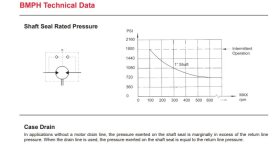KYErik
Platinum Member
- Joined
- Dec 2, 2005
- Messages
- 893
- Location
- South central IL
- Tractor
- 1977 AC 7000, 1980 JD 2840, 1963 Case 930, 1963 Ford 4000, 1943 Case SC, Case 530CK backhoe
I posted some questions last month about a leaky hydraulic motor and ended up buying a new 22 cu. inch low speed motor from surplus center. This motor has a case drain (in addition to the pressure and return lines). From what I have read, it is very important for the longevity of the motor's shaft seal to plumb the case drain directly back to your hydraulic sump so there is no back pressure (not even through the return filter).
I will be using several different tractors with the auger cart so it would require lots of time to install a quick connect fitting on the rear housing of each to return the fluid directly to the sump. These tractors are older and will all run less than 1400 psi.
Since this 200 bushel auger cart will probably only be filled/emptied a maximum of 5 times per year, my idea is to simply run a long case drain hose into the small opening of the lid of an empty 5 gallon hydraulic fluid bucket. I know that the case drain just gives fluid that leaks through the internal parts a place to go. But what flow rate should I expect? It should take less than 10 minutes of running the auger to empty the cart- so would the flow rate likely be less than 0.5 gallons per minute? I wouldn't want to have to line up several 5 gallon buckets just to catch the fluid that comes through in 10 minutes...
I will be using several different tractors with the auger cart so it would require lots of time to install a quick connect fitting on the rear housing of each to return the fluid directly to the sump. These tractors are older and will all run less than 1400 psi.
Since this 200 bushel auger cart will probably only be filled/emptied a maximum of 5 times per year, my idea is to simply run a long case drain hose into the small opening of the lid of an empty 5 gallon hydraulic fluid bucket. I know that the case drain just gives fluid that leaks through the internal parts a place to go. But what flow rate should I expect? It should take less than 10 minutes of running the auger to empty the cart- so would the flow rate likely be less than 0.5 gallons per minute? I wouldn't want to have to line up several 5 gallon buckets just to catch the fluid that comes through in 10 minutes...

